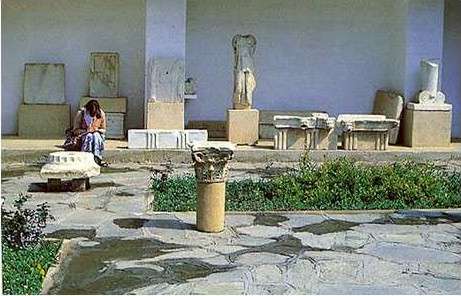|

| The island has been inhabited since the Early Cycladic
period (3200-2700 B.C.), and many objects have been found in settlements of that time,
such as the one in Saliagos, an islet between Paros and Antiparos. It is believed that the
two islands used to form one land in much earlier times. In Paros, important archaic
burial grounds have been discovered in Abyssos and Kampos, while another archaic cemetery,
recently unearthed in Parikia itself, is now being opened to the public. |

| In the Archaeological Museum of Parikia you can admire finds dating from
the Early Cycladic period down to Classical as well as Roman times. The museum also houses
a part of the frieze of the archaic site of Archilochion, where the tomb of the lyrical
poet Archilochus is believed to be. |

| In the earliest antiquity Paros used to be called Minoa,
from the first settlers that came from the Minoan Crete. Later it was occupied by
Arcadians, led by Parios son of Parrasios, who gave the island its definitive name. After
the Arcadians, Paros was inhabited by Ionians. |


It was during their time that Paros started flourishing
and even founded a colony on the island of Thassos.Paros was the birthplace of several
poets and artists, among them the elegist Euenos, the sculptor Agoracritos, pupil of
Phidias, and the painters Arkesilaos and Nicanor. The most famous Parian personality,
though, was the lyrical poet Archilochus. He was the first poet in history who accentuated
the personal element rather than the heroic, prevalent at that time. His style was satiric
and highly sarcastic, even when the object was himself. Archilochus had a difficult and
turbulent life, which enabled him to transcend the standards of his contemporaries and
create such a distinctive revolutionary poetry. |

| Paros was also famed in all the ancient world for its
marble. It was of excellent quality, white and very fine grained, and came from quarries
called «lichnites». This marble was used in masterpieces still surviving today, in
Athens, Delos, and many other sites. Following the Persian wars, Paros was successively
occupied by the Macedonias, the Ptolemies, Mithridates, and the Romans. After its
conversian to Christianity, when it became a part of the Byzantine Empire, many churches
and monasteries were built in Paros, the most famous among them being the church of
Panagia Ekatontapiliani (Our Lady of the Hundred Gates) in Parikia. |


| According to one tradition, the church was built by St. Helena, mother of
Constantine the Great, and recent finds seem to support this. Others say that Katapoliani,
as the locals call it, was built during the reign of Emperor Justinian, though there was a
pre-existing church which in turn was constructed on the site of an ancient gymnasium or
theatre. |
| In the centuries that followed Ekatontapiliani suffered much damage, the
most severe being the collapse of its done. Now restored, it is considered one of the most
important early Byzantine monuments in Greece. For Orthodox Church, though, it is not just
a monument, it is a great shrine, a place for worship. |


| The icon of the Virgin Mary is regarded as miraculous, and a big
religious feast takes place here on the 15th of August, day of the Assumption. Thousands
of pilgrims come seeking Her grace, and many moving scenes are witnessed by any attendant.
In 1207 Paros was conquered by the Venetians and thence formed part of the Duchy of Naxos.
Under Venetian and Frankish rule a thriving Catholic community established itself on the
island, with families whose names still survive in Paros. The only dark spot in the
history of Paros is the frequent pirate raids that ravaged the island and caused a lot of
damage and human loss. After the Turkish rule, following the Greek War of Independence,
Paros was incorporated in the Greek State along with the rest of the Cyclades. |

Send mail to webmaster@parosweb.gr
with questions or comments about this web site.
Copyright © 1998 - 1999 ® PAROS WEB SERVER!
Last modified:07/01/1999
|